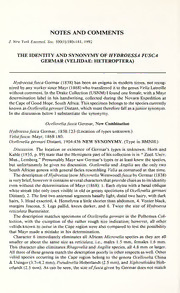
The Identity and Synonymy of Hydroessa fusca Germar (Veliidae: Heteroptera) PDF
Preview The Identity and Synonymy of Hydroessa fusca Germar (Veliidae: Heteroptera)
NOTES AND COMMENTS J. New York Entomol. Soc. 100(1):180-181, 1992 THE IDENTITY AND SYNONYMY OF HYDROESSA FUSCA GERMAR (VELIIDAE: HETEROPTERA) Hydroessafusca Germar (1838) has been an enigma in modem times, not recog- nized by any worker since Mayr (1 868) who transferred it to the genus Velia Latreille without comment. In the Drake Collection (USNM) I found one female, with a Mayr determination label in his handwriting, collected during the Novara Expedition at the Cape ofGood Hope, South Africa. This specimen belongs to the species currently known as Ocellovelia germari Distant, which must therefore fall as ajunior synonym. In the discussion below I substantiate the synonymy. Ocellovelia fusca Germar, New Combination Hydroessafusca Germar, 1838:123 (Location of types unknown.) Veliafusca. Mayr, 1868:180. Ocellovelia germari Distant, 904:436 NEW SYNONYMY. (Type in BMNH.) 1 Discussion. The location or existence of Germar’s types is unknown. Horn and Kahle (1935, p. 89) state that the Hemiptera part ofhis collection is in “ Zool. Univ. Mus., Lemberg.” Presumably Mayr saw Germar’s types or at least knew the species, but unfortunately he gives no discussion. Ocellovelia and Angilia are the only two South African genera with general facies resembling Velia as construed at that time. The description ofHydroessa (now Microvelia Westwood)fusca by Germar (1838) is very brief, however it contains several characters that provide clues as to its identity even without the determination of Mayr (1868): 1. Each elytra with a basal oblique white streak (the only ones visible in old or greasy specimens of Ocellovelia germari Distant), 2. The first two antennal segments basally light, distal two hairy, with dark hairs, 3. Head exserted, 4. Hemelytra a little shorter than abdomen, 4. Venter black, margins fuscous, 5. Legs pallid, knees darker, and 6. Twice the size of Hydroessa reticulata Burmeister. The description matches specimens of Ocellovelia germari in the Polhemus Col- lection, with the exception of the rather rough size indication; however, all other veliids known to occur in the Cape region were also compared to test the possibility that Mayr made a mistake in his determination. Character 6 immediately eliminates all African Microvelia species as they are all smaller or about the same size as reticulata, i.e., males 1.5 mm, females 1.6 mm. mm This character also eliminates Rhagovelia and Angilia species, all 4.8 or larger. All three ofthese genera match the description poorly in other respects as well. Other veliid species occurring in the Cape region belong to the genera Ocellovelia China & Usinger (3.7-4.2 mm), Pseudovelia Hoberlandt (2.5 mm), and Xiphoveloidea Hob- erlandt (2.5 mm). As can be seen, the size offusca given by Germar does not match NOTES AND COMMENTS 1992 181 any of the latter three genera very closely so we must examine other characters for the latter two genera. Pseudovelia species agree in the following: Venter black with fuscous margins; first antennal segment basally pallid. They disagree in the following: Hemelytra with four (2 + 2) oblique diffuse sordid white streaks; head not exserted; distal antennal seg- ments with light colored hairs; hemelytra longer than abdomen. Xiphoveloidea species agree in the following: Hemelytra with oblique basal white streaks. They disagree in the following: Venter black, without fuscous margins; first antennal segment uniformly dark; head not exserted; distal antennal segments with light colored hairs; hemelytra longer than abdomen (macropterous form rare). The possibility remains thatfusca could be synonymous with Ocellovelia distanti China and Usinger, but this species is rare, and is darker, which does not match Germar’s description stating thatfusca is dorsally fuscous. The conclusion is that no other veliid matches the description offusca as well as Ocellovelia germari Distant, and this species is common in the Cape region; thus, Mayr’s determination is supported, and germari must fall as a synonym. Because no type-material of Hydroessa fusca Germar is known to exist, and in order to insure stability, I here designate a neotype, to be placed in the U.S. National Museum of Natural History, Washington, D.C. The neotype data is as follows: macropterous male, South Africa, Cape Province, Blinkwater Falls, Table Mt., Cape- town, XI-21-1949, B. Malkin.—John T. Polhemus, University ofColorado Museum, 3115 South York St., Englewood, Colorado, USA 80110. ACKNOWLEDGMENTS I am indebted to R. C. Froeschner, Smithsonian Intitution, U.S. National Museum ofNatural History (USNM), Washington, D.C. for the opportunity to study material in the Drake Col- lection under his care. LITERATURE CITED Distant, W. L. 1904. On South African Tingidae and other heteropterous Rhynchota. Trans. S. Afr. Phil. Soc. 14:425-436, pi. 8. Germar, E. F. 1838. Hemiptera Heteroptera promontorii bonae spei nundum descripta, quae collegit C. F. Drege. Silbermann’s Rev. Entomol. 5:121-192. Horn, W. and E. Kahle. 1935. Uber entomologische Sammlungen, Entomologen & Entomo- Museologie. Entomol. Beih. 2:1-160, pis. 1-16. Mayr, G. 1868. Hemiptera. In: Reise der Osterreichischen Freggate Novara um die Erde in den Jahren 1857, 1858, 1859. Teil, II, Abt. I, Wien, 204 pp., 5 pis.
